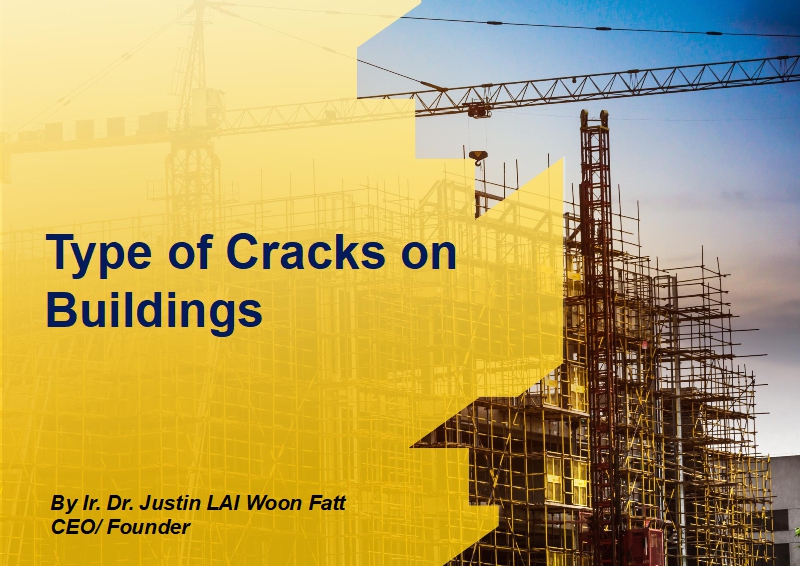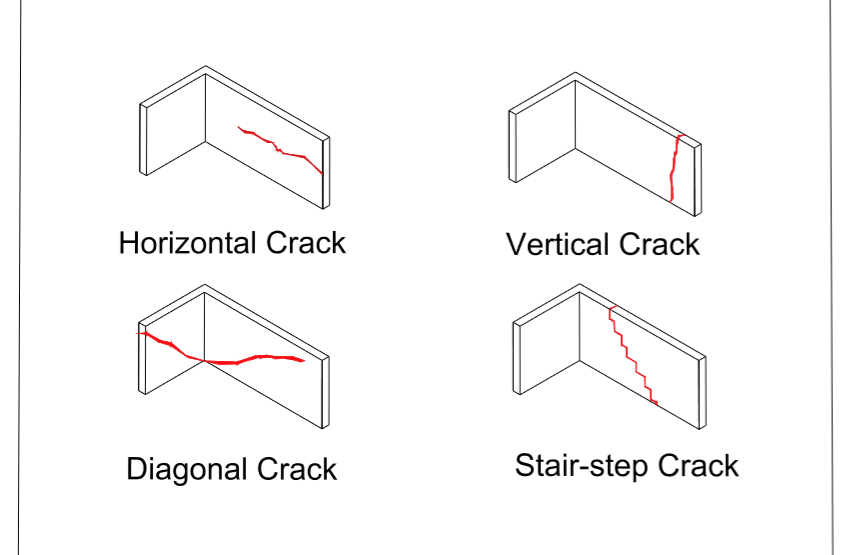Author: Ir. Dr. Justin LAI Woon Fatt | 24 March, 2020
What are non-structural cracks?
Non-structural cracks are less aggressive and at present state do not threaten the structural integrity of buildings. They are usually the sign of aging that change in moisture content, thermal and weather condition over time will naturally cause non-structural cracks to appear. [1] There are some other factors causing non-structural cracks such as creep damage, vegetation or trees, shifting or moving foundations, settlement, and hydrostatic pressure. They can occur anywhere in the foundation when there are voids or openings on the foundation walls. They are usually thin hairline cracks less than 2.0 mm. However, non-structural cracks should be well monitored and treated since they might turn into structural cracks when water seeps through and deteriorate the inner concrete, widening the cracks.
What are structural cracks?
Structural cracks are more truculent and at present state threaten the structural integrity of the building. They are often caused by incorrect design, poor construction sites, swollen soil, chemical reaction of construction materials, overloading and differential settlement due to insufficient soil bearing strength and load carrying capacity. They typically accompanied by problems like sticking doors or windows, slanted doors, and sloping floors. Generally, structural cracks appear wider than 2.0 mm; they can be continuous horizontal cracks along walls, vertical cracks significantly wider at top or bottom, diagonal cracks and stair-step cracks. They can emerge in foundation walls, beam, slabs, and columns or even extend to upper levels of the building. [1]
Figure 1: Cracks Pattern
Type of Cracks
- Plastic shrinkage concrete cracks (Can be Structural or Non-structural Cracks)The concrete is full of water when it is still in the plastic state (before hardening). Due to the settlement of large solid particles under gravity, bleeding of concrete happens and water in concrete rises. When the rate of evaporation from the concrete surface exceeds the rate of bleeding, shrinkage takes place. Since concrete cannot resist against tension in the plastic state, cracks develop on the surface. Also, when the water fully evaporates, there are many large voids left between the solid particles; these voids weaken the concrete strength, making them more susceptible to cracking. Hence, hot weather and excessively wet concrete mix (the mix that contains too much water) are the main reasons contributing to plastic shrinkage in concrete.
Plastic shrinkage cracks often take place in slab and walls especially reentrant corners or with circular parts in the slab middle such as pipes, drains, and manholes. Since it is difficult for shrinkage of concrete to occur at corners or circular parts, the stress will cause the concrete to crack from the corners or circular parts. Although plastic shrinkage cracks are very narrow and almost invisible when viewed from the surface, they can extend deep into the slab and even throughout the entire slab thickness. [2]
- Expansion concrete cracks (Can be Structural or Non-structural Cracks)All construction materials expand on heating and contract on cooling with the magnitude of expansion and contraction depends on their properties. Thermal variation (increase in temperature) causes the concrete to expand and press against the wall or adjacent slab. The concrete will eventually crack due to the expansion force when both the wall and slab do not have enough ability to flex. Since the cracks usually get filled with dust and dirt, the grit formation prevents the cracks from closing up when the temperature drops. [2]
- Heaving concrete cracks (Non- structural cracks)The existence of vegetation may cause the walls to crack that the growing roots can extend up to the foundation, lift and crack the concrete. If the foundation soil is shrinkable clay, the dehydrating action of growing roots on the shrinkable soil might cause settlement of the foundation.
- Cracks caused by foundation settlement (Structural cracks)Shear cracks are likely to happen due to large differential settlement in the foundation caused by varying soil and loading conditions. Buildings constructed on expansive soils more prone to cracking because of their tendency of swelling and shrinkage due to variation in moisture content. Diagonal cracks often occur due to the movement of foundation at the corners of buildings. Buildings constructed on made-up soil may experience non-uniform settlement when there is a flow of excess water from heavy rains or floods into the foundation.
- Concrete cracks caused by slab overloading (Structural cracks)Cracks caused by the overload on actual slab might be common in factory/industrial concrete slabs especially where heavy materials, machinery, and equipment often placed and where large vehicles such as concrete transport truck, mobile crane, log carrier and ballast tractor often parked. When the ground below the slab is overloaded, the excess load on the slab pushes hard against the concrete, causing the concrete surface to be in the tension zone. If the reinforcement provided is insufficient, concrete cracks will develop.
- Concrete cracks caused by premature drying (Non- structural cracks)
Crazing cracks and crusting cracks usually take place when the top of the concrete slab loses moisture too fast than the bottom. Crazing cracks are fine cracks on the surface that resemble spider webs and shattered glass while crusting cracks happen when embedded stamp pulls the surface apart near the stamped joints.
Conclusion
There are various solutions to repair structural cracks such as sealing, epoxy injection method, stitching, drilling and plugging. Repairing structural cracks can be time and cost-consuming, hence the type and nature of cracks need to be clearly identified to select the right method of repairing cracks. It is better to consult with professional engineers or experts to recognize the cause of cracks and find the best option to save money, time and energy.
Ir. Dr. Justin LAI Woon Fatt
CEO/ Founder
IPM Group
References:
[1] Epp Concrete (December 2015) Structural or Non-Structural? Understanding Foundation Cracks. Retrieved on 18th March 2020 from https://www.eppconcrete.com/structural-or-non-structural-understand-foundation-cracks/
[2] 6 Types of Concrete Cracks and What They Mean? Retrieved on 20th March 2020 from https://concretesupplyco.com/6-concrete-cracks/


